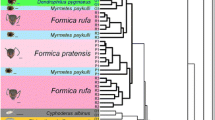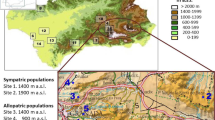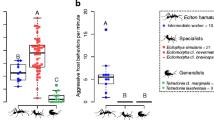Abstract
Formica ants are not known to be prey specialists on other ant species, however, for the past 60 years, field observations on Formica archboldi in the southeastern United States have noted that their nests are scattered with body parts of Odontomachus trap-jaw ants. This study investigates the relationship between F. archboldi and Odontomachus. Through a series of behavioral experiments and a descriptive study of their chemical ecology, I find: (1) behavioral evidence that F. archboldi are more capable predators of Odontomachus in comparison to other Formica. (2) F. archboldi match the cuticular hydrocarbon profiles of the native species of Odontomachus that they occur with. This includes O. brunneus and O. relictus and the intraspecific variation found across Florida populations of O. brunneus. (3) F. archboldi do not display a prey retrieval preference towards hydrocarbon-matching Odontomachus as compared to mismatching. (4) F. archboldi that match Odontomachus hydrocarbon profiles do not receive lower levels of aggression than mismatching F. archboldi. Beyond providing natural history insights into the relationship between these species, this study expands our knowledge of an important insect chemical phenotype. The intraspecific variability in F. archboldi cuticular hydrocarbon profiles is among the greatest reported for social insects and provides a unique case of how non-parasitic species can generate parasite-like chemical-mimic phenotypes.




Similar content being viewed by others
References
Ayre GL (1968) Comparative studies on the behaviour of three species of ants (Hymenoptera: Formicidae) I. Prey finding, capture, and transport. Can Entomol 100:165–172
Bagnères AG, Lorenzi MC (2010) Chemical deception/mimicry using cuticular hydrocarbons. In: Blomquist GJ, Bagnères AG (eds) Insect hydrocarbons: biology, biochemistry, and chemical ecology. Cambridge University Press, Cambridge, pp 282–324
Bauer S, Bohm M, Witte V, Foitzik S (2010) An ant social parasite in-between two chemical disparate host species. Evol Ecol 24:317–332
Blomquist GC, Bagnères A-G (2010) Insect hydrocarbons: biology, biochemistry, and chemical ecology. Cambridge University Press, Cambridge
Brandão CRF, Diniz JLM, Tomotake EM (1991) Thaumatomyrmex strips millipedes for prey: a novel predatory behavior in ants, and the first case of sympatry in the genus (Hymenoptera: Formicidae). Insect Soc 38:335–344
Buczkowski G, Kumar R, Suib SL, Silverman J (2005) Diet-related modification of cuticular hydrocarbon profiles of the Argentine ant, Linepithema humile, diminishes intercolony aggression. J Chem Ecol 31:829–843
Carlson DA, Bernier UR, Sutton BD (1998) Elution patterns from capillary GC for methyl-branched alkanes. J Chem Ecol 24:1845–1865
Cerquera LM, Tschinkel WR (2010) The nest architecture of the ant Odontomachus brunneus. J Insect Sci 10:64
Clarke KR (1993) Non-parametric multivariate analyses of changes in community structure. Aust J Ecol 18:117–143
D’Ettorre P, Errard C, Ibarra F, Francke W, Hefetz A (2000) Sneak in or repel your enemy: Dufour’s gland repellent as a strategy for successful usurpation in the slave-maker Polyergus rufescens. Chemoecology 10:135–142
Dejean A, Evraerts C (1997) Predatory behavior in the genus Leptogenys: a comparative study. J Insect Behav 10:177–191
Deyrup M (2017) Ants of Florida: identification and natural history. CRC, Boca Raton
Deyrup M, Cover S (2004) A new species of Odontomachus ant (Hymenoptera: Formicidae) from inland ridges of Florida, with a key to Odontomachus of the United States. Fla Entomol 87:136–144
Guillem RM, Drijfhout FP, Martin SJ (2016) Species-specific cuticular hydrocarbon stability within European Myrmica ants. J Chem Ecol 42:1052–1062
Hart LM, Tschinkel WR (2012) A seasonal natural history of the ant, Odontomachus brunneus. Insect Soc 59:45–54
Hölldobler B, Wilson EO (1990) The ants. Harvard University Press, Cambridge
Jongepier E, Foitzik S (2016) Ant recognition cue diversity is higher in the presence of slavemaker ants. Behav Ecol 27:304–311
King JR, Trager JC (2007) Natural history of the slave making ant, Polyergus lucidus, sensu lato in northern Florida and its three Formica pallidefulva group hosts. J Insect Sci 7:1–14
Kleeberg I, Foitzik S (2016) The placid slavemaker: avoiding detection and conflict as an alternative, peaceful raiding strategy. Behav Ecol Sociobiol 70:27–39
Larabee FJ, Suarez AV (2014) The evolution and functional morphology of trap-jaw ants (Hymenoptera: Formicidae). Myrmecol News 20:25–36
Leal IR, Oliveira PS (1995) Behavioral ecology of the neotropical termite-hunting ant Pachycondyla marginata: colony founding, group-raiding and migratory patterns. Behav Ecol Sociobiol 37:373–383
Liang D, Silverman J (2000) “You are what you eat”: diet modifies cuticular hydrocarbons and nestmate recognition in the Argentine ant, Linepithema humile. Naturwissenschaften 87:412–416
Liu Z, Bagnères AG, Yamane S, Wang Q, Kojima J (2003) Cuticular hydrocarbons in workers of the slave-making ant Polyergus samurai and its slave, Formica japonica (Hymenoptera: Formicidae). Entomol Sci 6:125–133
Lorenzi MC, Azzani L, Bagneres AG (2014) Evolutionary consequences of deception: complexity and informational content of colony signature are favored by social parasitism. Curr Zool 60:137–148
Macgown JA, Boudinot B, Deyrup M, Sorger DM (2014) A review of the Nearctic Odontomachus (Hymenoptera: Formicidae: Ponerinae) with a treatment of the males. Zootaxa 3802:515–552
Martin SJ, Helantera H, Drijfhout FP (2008) Evolution of species-specific cuticular hydrocarbon patterns in Formica ants. Biol J Linnean Soc 95:131–140
Martin SJ, Helantera H, Drijfhout FP (2011) Is parasite pressure a driver of chemical cue diversity in ants? P Roy Soc B Biol Sci 278:496–503
Regnier FE, Wilson EO (1971) Chemical communication and propaganda in slave-maker ants. Science 172:267–269
Smith AA, Liebig J (2017) The evolution of cuticular fertility signals in eusocial insects. Curr Opin Insect Sci 22:79–84
Smith AA, Millar JG, Hanks LM, Suarez AV (2012) Experimental evidence that workers recognize reproductives through cuticular hydrocarbons in the ant Odontomachus brunneus. Behav Ecol Sociobiol 66:1267–1276
Smith AA, Millar JG, Hanks LM, Suarez AV (2013) A conserved fertility signal despite population variation in the cuticular chemical profile of the trap-jaw ant Odontomachus brunneus. J Exp Biol 216:3917–3924
Smith AA, Millar JG, Suarez AV (2015) A social insect fertility signal is dependent on chemical context. Biol Lett 11:20140947
Smith AA, Millar JG, Suarez AV (2016) Comparative analysis of fertility signals and sex-specific cuticular chemical profiles of Odontomachus trap-jaw ants. J Exp Biol 219:419–430
Smith AA, Vanderpool W, Millar JG, Hanks LM, Suarez AV (2014) Conserved male-specific cuticular hydrocarbon patterns in the trap-jaw ant Odontomachus brunneus. Chemoecology 24:29–34
Smith MR (1944) Additional ants recorded from Florida, with descriptions of two new subspecies. Fla Entomol 27:14–17
Torres CW, Tsutsui ND (2016) The effect of social parasitism by Polyergus breviceps on the nestmate recognition system of its host, Formica altipetens. Plos One 11:e0147498
Trager JC (2013) Global revision of the dulotic ant genus Polyergus (Hymenoptera: Formicidae, Formicinae, Formicini). Zootaxa 3722:501–548
Trager JC, Johnson C (1985) A slave-making ant in Florida: Polyergus lucidus with observations on the natural history of its host Formica archboldi (Hymenoptera: Formicidae). Fla Entomol 68:261–266
Trager JC, MacGown JA, Trager MD (2007) Revision of the nearctic endemic Formica pallidefulva group. Mem Am Entomol Inst 80:610–636
Van Pelt AFJ (1958) The ecology of the ants of the Welaka Reserve, Florida (Hymenoptera: Formicidae). Part II. Annotated List. Am Midl Nat 59:1–57
Włodarczyk T, Szczepaniak L (2017) Facultative slave-making ants Formica sanguinea label their slaves with own recognition cues instead of employing the strategy of chemical mimicry. J Insect Phys 96:98–107
Acknowledgements
Thanks to Coby Schal for access to equipment. Thanks to Adam Bowen for assistance with experiments. Thanks to Archbold Biological Station and Florida Department of Agriculture and Consumer Services for access to field sites. Thanks to Andrew Suarez and Omar Halawani for comments on the manuscript.
Author information
Authors and Affiliations
Corresponding author
Electronic supplementary material
Below is the link to the electronic supplementary material.
Supplementary material 2 (MP4 125010 KB)
Supplementary material 3 (MP4 24595 KB)
Rights and permissions
About this article
Cite this article
Smith, A.A. Prey specialization and chemical mimicry between Formica archboldi and Odontomachus ants. Insect. Soc. 66, 211–222 (2019). https://doi.org/10.1007/s00040-018-0675-y
Received:
Revised:
Accepted:
Published:
Issue Date:
DOI: https://doi.org/10.1007/s00040-018-0675-y




